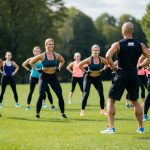DIY Yoga for Beginners: Essential Poses and Practices to Get Started
Balancing Poses
Balancing poses are crucial for developing concentration and physical stability. Tree Pose (Vrksasana) is a fundamental balancing pose improving posture and balance. Eagle Pose (Garudasana) enhances coordination and strengthens the ankles.
Half Moon Pose (Ardha Chandrasana) challenges the balance while stretching the legs and spine. Focusing the gaze on one point aids in maintaining stability. Regular practice of balancing poses improves overall stability and coordination.
Twists and Inversions
Twists detoxify and restore the spine’s natural range of motion. Seated Spinal Twist (Ardha Matsyendrasana) massages the abdominal organs and improves digestion. Revolved Triangle Pose (Parivrtta Trikonasana) stretches the legs and opens the chest.
Inversions like Shoulder Stand (Sarvangasana) increase blood flow to the brain, enhancing focus and calm. Twists and inversions rejuvenate the body and mind, offering both physical and mental benefits.
Breathing Techniques: Pranayama Basics
Pranayama is the practice of controlled breathing, essential in yoga to harmonize the body and mind. Beginners should start with simple techniques.
Ujjayi Breath: This technique involves breathing deeply through the nose while slightly constricting the back of the throat, creating a gentle hissing sound. It helps in focusing the mind and calming the nervous system.
Nadi Shodhana (Alternate Nostril Breathing): It balances the body’s energy channels. One nostril is closed while inhaling through the other, then the nostrils are switched for exhaling. This process continues alternately.
Bhramari (Bee Breath): This involves creating a humming sound while exhaling. The vibration soothes the mind and aids in reducing stress. Practitioners keep their eyes closed while performing this technique.
Consistency is key in practicing Pranayama. Set aside a few minutes daily to develop a strong foundational breathing practice. Start with a comfortable seated position and maintain a straight spine for optimal airflow.
Combining Poses: Creating a Sequence
Incorporating multiple yoga poses into a flowing sequence can enhance the practice, promoting both physical and mental benefits. Understanding how to connect these poses seamlessly is key to building a robust yoga routine.
The Sun Salutation
The Sun Salutation, or Surya Namaskar, is a foundational sequence in yoga comprising a series of 12 poses. It begins with the Mountain Pose, moves through Forward Bend, Plank, and Cobra, and concludes with Downward-Facing Dog. Each pose transitions smoothly into the next, coordinating with the breath.
Start in Mountain Pose, standing tall with feet together. Move into a Forward Bend followed by stepping back into Plank. Lower down into Chaturanga Dandasana, then transition into Cobra Pose by arching the back. Push back into Downward-Facing Dog, and step or jump forward to return to a Forward Bend. Conclude by rising back into Mountain Pose.
Basic Flow Sequences
Basic yoga flow sequences often combine standing, balancing, and seated poses, creating a dynamic yet accessible practice. A typical sequence might start with a few rounds of Sun Salutation to warm up, followed by Warrior poses, Tree Pose, and finishing with seated stretches.
Begin in Mountain Pose and transition through the Sun Salutation to warm up. Move into Warrior I, holding for a few breaths, then shift to Warrior II and Reverse Warrior. Transition into Tree Pose for balance, followed by seated stretches like Seated Forward Bend and Butterfly Pose. Each pose should flow naturally from one to the next, maintaining a steady breath.



